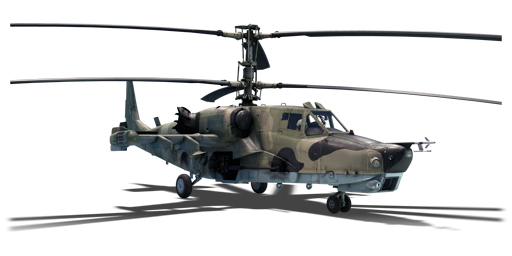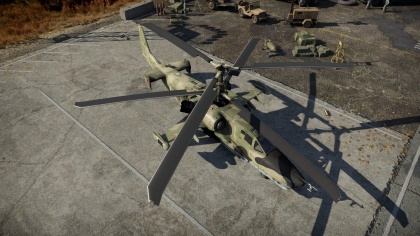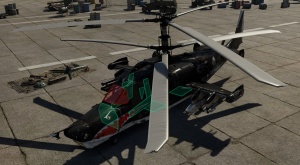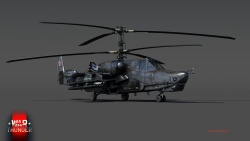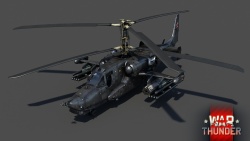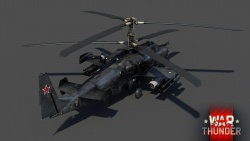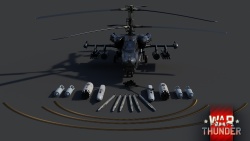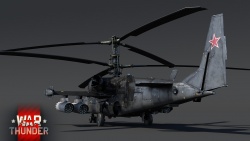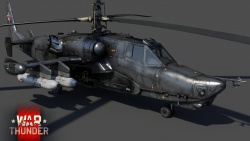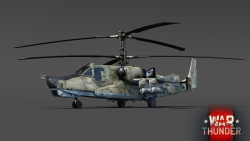Difference between revisions of "Ka-50"
CobraKingII (talk | contribs) m (→History) (Tag: Visual edit) |
CobraKingII (talk | contribs) (→History) (Tag: Visual edit) |
||
| Line 178: | Line 178: | ||
'''Development''' | '''Development''' | ||
| + | |||
| + | ... | ||
| + | |||
| + | The Ka-50 is the production name for the V-80Sh-1prototype; production was authorized on 14 December 1987. The Western nations first saw reports of its development in 1984, and the first photograph was seen in 1989. The design went through testing from 1985 to 1986, and the pilot workload was found to be comparable to that of a fighter-bomber. As such, one pilot was sufficient for the operation of the helicopter, and space was only provided for one crew member. | ||
'''Design''' | '''Design''' | ||
Revision as of 18:53, 5 September 2020
Contents
Description
The Ka-50 is a gift rank VI Soviet helicopter
with a battle rating of 10.7 (AB), 11.3 (RB), and 10.3 (SB). It was introduced in Update 1.93 "Shark Attack".
General info
Flight performance
| Characteristics | ||
|---|---|---|
| Stock | ||
| Max Speed (km/h at 1,000 m) |
Max altitude (meters) | |
| AB | RB | |
| 299 | 268 | 5100 |
| Upgraded | ||
| Max Speed (km/h at 1,000 m) |
Max altitude (meters) | |
| AB | RB | |
| 320 | 310 | 5100 |
Survivability and armour
Due to the low weight, this helicopter is fast and agile, and so it is easy to dodge even the missiles from ADATS or incoming fighters on head-on. Even in the case of damages, the twin rotor design can help keep control the damage even in cases where the tail is destroyed.
Lots of sensors on the Ka-50 help establish situational awareness to keep an eye for threats. A passive radar will keep the Ka-50 informed of the presence (distance and direction) of active radars (enemies AA, jets with radar), also with sounds (beeping). A Missile Approach Warning system (MAW) will automatically deploy false targets - flares (128 pcs) and inform the Ka-50 pilots of incoming missiles (even in SB). In other environmental conditions, the Ka-50 also has a night vision device (only image an intensifier without thermal sight) to keep some form of visibility.
Distance is also the Ka-50's best friend, with an ATGM with active radius of 10km that will help keep the helicopter out of range of most AA, except ADATS and 2K22 Tunguska.
The crew has a highly armoured cockpit, as shown in image: Black shark: Armour locations
- Bullet proof glass covers only the front windscreen of the helicopter - 22 mm thick.
- Aluminium alloy covers the front, and sides of the helicopter located on each side of the cockpit - 20 mm thick.
- Aluminium alloy covers only the bottom of the self-sealing fuel tanks - 20 mm thick.
The helicopter has four separate fuel tanks, three at the rear of the fuselage and one just behind the cockpit. Engines are placed above the auto-cannon with the fuel tanks, spaced out around it.
Armaments
Offensive armament
The Ka-50 is armed with:
- 1 x 30 mm 2A42 cannon, right fuselage-mounted (460 RPG)
The 30mm 2A42 cannon can be equipped with mixed belt, belt for air targets or ground targets
- Default belt: AP-T/HEF-I/HEF-I/AP-T/AP-T; max penetration: 62 mm at 100 metres
- Ground targets belt: AP-T/APDS/APDS/APDS/APDS; max penetration: 81 mm at 100 metres
- Air targets belt: HEF-T/HEF-I/HEF-I/HEF-I/HEF-I; max penetration: 3 mm at any distance
Due to the risk of flying directly over a battlefield, and that the Ka-50's optimal firing distance is from a long way from the enemy ground targets, the Ground target belt for the 30 mm is not useful. As such, being equipped against air targets would be better; so pick default or Air targets belt from personal preferences, but the default belt will have some AP shells in case the opposing enemy aircraft is armoured.
Suspended armament
The Ka-50 can be outfitted with the following ordnance:
- Without load
- 80 x S-8KO rockets
- 4 x 23 mm GSh-23-2 cannons
- 2 x 23 mm GSh-23-2 cannons + 40 x S-8KO rockets
- 12 x 9K127 Vikhr
- 2 x 23 mm GSh-23-2 cannons + 12 x 9K127 Vikhr
- 12 x 9K127 Vikhr + 40 x S-8KO rockets
- 4 x 250 kg OFAB-250-270 bombs
- 2 x 500 kg FAB-500M-54 bombs
- 2 x 23 mm GSh-23-2 cannons + 2 x 9M39 Igla + 6 x 9K127 Vikhr
- 2 x 9M39 Igla + 6 x 9K127 Vikhr + 40 x S-8KO rockets
The Ka-50 equip these weapons by means of pylons, with 4 pylons total on the helicopter (2 on each wing). Each pylon holds one of the following:
- 6 x 9K127 Vikhr ATGM (Range: 10 km; TNT equivalent: 5.16 kg; Max speed: 600 m/s) - A tandem warhead with 1000 mm penetration of armour after ERA with proximity fuse. Could only be mounted on the outer pylons for 12 missiles maximum
- 2 x 9M39 Igla A2A missile (IR guiding; Lock-on range: 6 km in rear aspect/4 km in all aspect; Max speed: 1,000 m/s; Max overload: 18 G; Has ECCM) - Mounted on outer pylons with 2 missiles each. Can currently only be equipped on 1 outer pylon, with the other having 6x Vikhr ATGM.
- 20 x S-8KO unguided rockets (Speed: 610 m/s; TNT equivalent: 1.32 kg; Max armour penetration: 400 mm) - All four pylons can be equipped with rocket pod for a maximum of 80 rockets total.
- 1 x 23mm Gsh-23-2 cannon with 250 ammo each, could be equipped all 4 pylons (1000 ammo with 4 cannons in total)
Defensive armament
The Ka-52 has a HIRSS - hover infrared suppressor subsystem, a MAW - Missile Approach Warning system and 128 Flares.
- 128 Flares are installed on tips of the wings, in those two pods.
- The Missile Approach Warning (MAW) detects the incoming missile and notifies you about them as well deploying the flares automatically.
Usage in battles
The most preferable play style for this helicopter should be firing ATGM from long range since Vikhr has the longest range in the game (10 km).
The only other 2 vehicles that has the shooting range of 10 km is the ADATS and 2K22 Tunguska. Since Tunguska in usually in your team (if not in a mixed battle), your only enemy is ADATS and/ or enemy planes.
Versus ADATS - From the beginning, try to keep the ADATS more than 10 km away from the Ka-50's position and focus on closer targets. For this, reach the battlefield at the middle (usually some point to capture is around 9.5 km from you). If the Ka-50 has already detected some ADATS within 10 km, be prepared with the fact that the ADATS also may know that the Ka-50 is there and may already be firing missiles. If an incoming missile is spotted, begin evasive maneuvers. To do this, turn-off hover mode and sharply turn the Ka-50 to one side (left or right) or do the barrel-roll. Never fire for at the ADATS after he fired first, his missiles are twice as fast as yours (1200 m/s vs 600 m/s). To eliminate the ADATS, lock-on target in gunner sight and fire. If you see incoming fire, switch to 3rd view/ pilot view and begin evasive maneuvers as mentioned above, but keep in mind that the target have to stay in your targeting view so your ATGM could hit the target while maneuvering.
Versus planes (jets) - On a head on, you can lock them and try to fire the Vikhr ATGM (it has proximity fuse) or lock them with Igla A2A (and fire only if distance is at least greater than 1 km). If they survived and approached their firing range, begin evasive maneuvers. Simply turn on one side (left or right) or do the barrel-roll. This is the only time you could use your right side mounted 30mm cannon, so use it and fire for enemy while maneuvering. If enemy passed you (and is still alive) turn around ASAP and lock him with your Igla A2A missiles and fire. In 99% of the cases, this should be enough to send any plane down.
If the is Ka-50 is not equipped with Igla missiles, just wait for the enemy pilot and repeat the process mentioned above until someone is shot down or have had the engagement broken off.
Modules
| Tier | Flight performance | Survivability | Weaponry | |||
|---|---|---|---|---|---|---|
| I | Compressor | Flak jacket | Offensive 30 mm | MAW | ||
| II | Helicopter frame | New 30 mm cannons | 9K121 Vikher | FAB-250 | ||
| III | Engine | Replacing helicopter blades | NVD | FAB-500 | ||
| IV | Cover | Gun pod UPK-23-250 | 9M39 | |||
Pros and cons
Pros:
- Has one of the best ATGM in the game (10 km range with 1000 mm penetration after ERA), able to fire after air targets with its proximity fuse.
- Fast and agile, maximum reached speed is around 330 km/h in level flight (with minimum fuel, payload of 6x Vikhr, 2x Igla and 2x Gsh-23-2 cannons in RB).
- Up to 12 9K127 Vikhr missiles which can be carried into combat, able to destroy a whole enemy team.
- The Ka-50's twin rotor concept can allow the helicopter to survive even after the tail is destroyed.
Cons:
- Limited choices of payload, compromises on ATGM and loadout payloads have to be made in order to use Igla air to air missiles.
- Absence of thermal sight can make enemy detection more difficult at lower altitude.
- Auto cannon is mounted on the right-hand side of the helicopter.
- Limited auto cannon firing arcs - Horizontal and Vertical angles.
History
Describe the history of the creation and combat usage of the helicopter in more detail than in the introduction. If the historical reference turns out to be too long, take it to a separate article, taking a link to the article about the vehicle and adding a block "/History" (example: https://wiki.warthunder.com/(Vehicle-name)/History) and add a link to it here using the main template. Be sure to reference text and sources by using <ref></ref>, as well as adding them at the end of the article with <references />. This section may also include the vehicle's dev blog entry (if applicable) and the in-game encyclopedia description (under === In-game description ===, also if applicable).
Development
...
The Ka-50 is the production name for the V-80Sh-1prototype; production was authorized on 14 December 1987. The Western nations first saw reports of its development in 1984, and the first photograph was seen in 1989. The design went through testing from 1985 to 1986, and the pilot workload was found to be comparable to that of a fighter-bomber. As such, one pilot was sufficient for the operation of the helicopter, and space was only provided for one crew member.
Design
The Ka-50 features a coaxial rotor design, and the rotors are made with polymers. Because of the coaxial rotor design no tail rotor is necessary, so it was excluded from the design. The powerplant features two Klimov VK-2500 engines; the Ka-50 has a high performance and maneuverability. It features an inertial navigation system (INS), an autopilot system, and a head-up display (HUD). A terrain-following radar is included, as is a Forward Looking Infrared (FLIR) device. Combat in both VFR and IFR conditions is allowed by the electronic radio and sighting-pilot-navigating system. These systems allow information such as enemy coordinates to be transmitted between helicopters and ground command systems.
A radar warning receiver, electronic warfare system, and chaff and flare dispensers with thirty-two 26 mm countermeasures each - located at the end of both wings - are fitted for the protection of the helicopter. The cockpit is armored for protection against 12.7 mm (.50 cal) armor-piercing bullets and 23 mm projectile fragments. The rotors are designed to withstand several hits from ground-based automatic weapons. Additionally, there is protection for vital systems, and the fuselage and landing gear are designed to be crash absorbing. The two engines increase survivability as well, for if one is damaged the other can still provide power.
The Ka-50 is armed with one Shipunov 2A42 30 mm cannon, which can attain a fire rate of 200 to 800 rounds per minute with its dual feed ammunition system; 460 rounds are carried. The cannon is mounted on the starboard side of the fuselage, and its traverse is limited to slight elevation and azimuth adjustments. The semi-rigid mounting allows a greater accuracy than would a turret mount. A K-37-800 ejection system is provided for the pilot, allowing escape at any altitude and speed.
The suspended armament is carried on four hardpoints mounted on the wings. These mounts can carry fuel tanks or various armaments, and they can be tilted up to ten degrees downwards. Twelve laser-guided 9K121 Vikhr or 9M120 anti-tank guided missiles can be carried. These missiles are claimed to be almost jam-proof and have fire-and-forget capability, allowing the helicopter to take evasive action after launch. The Ka-50 can also be fitted with S-13, S-8 rockets, or UPK-23-250 gun pods.
Service
The first major usage of the Ka-50 was during the Second Chechen War. Two Is-50s arrived in December of 2000; a Ka-29 operated with the Ka-50s to provie reconnaissance and target designation. The first time the Ka-50 used its weapons in combat was on 6 January 2001. On 9 January, one Ka-50 accompanied by an Mi-24 used S-8 unguided rockets to destroy a Chechen insurgent warehouse near Komsomolskoye which was used to store ammunition. On 6 February, the two Ka-50s and the Ka-29 destroyed an insurgent camp south of Tsentoroj with the launch of two 9K121 Vikhr missiles; they were launched at a range of 3 kilometers. On 14 February, the helicopters carried out a similar mission near Oak-Yurt and Hatun. The group had located and destroyed eight targets, and these operations in mountainous terrain validated the Ka-50 design.
The Ka-50 was used by the Russian Military during many military exercises, including "Boundary 2004" in the Edelweiss mountain range of Kyrgyzstan during August 2004. During this exercise, the Ka-50 operated at high altitudes and warm air temperatures. One Ka-50 was used to provide cover for landing troops and used cannons and rockets against ground targets.
Media
- Images
- Videos
See also
- Ka-52 - Another Soviet attack helicopter developed from the Ka-50.
- Mi-35M - A Soviet attack helicopter at the same BR.
- AH-64A and AH-64A "Peten" - American/Israeli attack helicopters at the same BR.
- AH-64DJP - A Japanese attack helicopter at the same BR.
- EC-665 Tiger HAP - A French attack helicopter at the same BR.
External links
| Kamov Design Bureau | |
|---|---|
| Attack | Ka-29 · Ka-50 · Ka-52 |
| USSR helicopters | |
|---|---|
| Attack | |
| Hound | Mi-4AV |
| Hip | Mi-8AMTSh · Mi-8AMTSh-VN · Mi-8TV |
| Hind | Mi-24A · ▂Mi-24D · Mi-24P · Mi-24V · Mi-35M |
| Havoc | Mi-28N · Mi-28NM |
| Helix | Ka-29 |
| Hokum | Ka-50 · Ka-52 |


